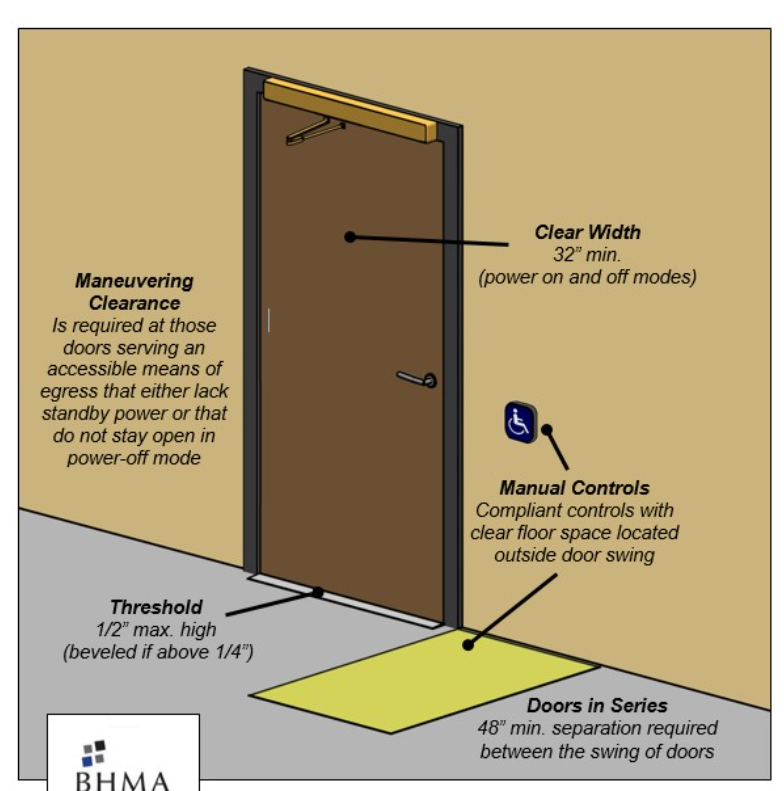What Are The ADA Door Opener Guidelines?
ADA stands for Americans With Disabilities Act, and is a national law that must be followed. The reach of the ADA is vast and it even includes the construction industry and ADA door openers. Specifically, there are ADA requirements that must be followed for all ADA door openers.
What Does ADA Classify As A Door Opener
First let us define an
ADA door opener. This is most commonly known as a handicap door opener or automatic door operator. It is a type of electromechanical swing door operator that uses an electric motor to automatically open the door, then a mechanical spring to gently close the door. In this article we will be specifically talking about ADA door opener requirements. If you are interested in automatic sliding door requirements, that is covered in our
Automatic Sliding Door resources.
Automatic and Power Assisted Doors
Per section 404.3 of the ADA requirements, it states "
doors are not required to be automated, but must comply when provided. The Standards apply industry Standards developed under protocols of the American National Standards Institute (ANSI) and published by the Builders Hardware Manufacturers Association (BHMA). The ANSI/BHMA Standards address operating characteristics, including opening speed, safety features, sensors and activation devices, and labeling, among others. Doors are classified by their type or level of automation." Meaning that all function and operation guidelines such as opening/closing/latch speed, safety signage, handicap push plate placement, etc is outlined by ANSI and should be followed.
![]()
ADA Activation Devices
Also per section 404.3 of the ADA requirements, it states "Low energy doors and gates usually require activation by the user through a push plate or control and are often used in moderate traffic locations as an alternative to manual operation. Most function like a manual type but with a powered opener and closer option." This simply means that an ADA compliant automatic door opener will have some sort of activation device to communicate with the automatic door motor to open the door or close it. Industry standard activation devices include
handicap push buttons or
touchless activation switches.
Also per section 404.3.5 of the ADA requirements, it states, "Door and gate controls must be compliant as operable parts (operable with one hand and without tight grasping, pinching, twisting of the wrist, or more than 5 lbf). This just indicates that the activation device for the ADA door opener must be operable with one hand. Handicap push to open activation buttons are flat and require no grasping, pinching, or twisting of the wrist, and no more than 5lb of force to use, therefore they qualify as a compliant activation device.
Clear Floor Space
Also per section 404.3.5 of the ADA requirements, it states that "Clear floor space at controls must be located outside the door swing to prevent users from getting hit by the door." This means that the activation device to automatically open the door, must be placed away from the door swing, as illustrated below. This will prevent pedestrians from getting hit by the swing of the door as it opens or closes.
![]()
![]()
Disclaimer: The material in this article has no regard to the specific installation, building code requirements, law requirements, authority having jurisdiction, local or state requirements, or any particular needs of any viewer. This article is presented solely for informational and entertainment purposes and is not to be construed as a recommendation or solicitation. Nor should any of its content be taken as advice. Automatic Door and Hardware is not an installation advisor. The views expressed in this article are completely speculative opinions and do not guarantee any specific result. Commercial doors, hardware, and automatic door parts should only be worked on by trained, qualified, and licensed professionals; failure to do so can result in danger. Any opinions expressed in this article are subject to change without notice. Automatic Door and Hardware is not under any obligation to update or keep current the information contained herein. Automatic Door and Hardware may have an interest in the securities and commodities of any entities referred to in this material. Automatic Door and Hardware accepts no liability whatsoever for any loss or damage of any kind arising out of the use of all or any part of this material. Automatic Door and Hardware recommends that you consult with a licensed and qualified professional before making any modifications or repairs to commercial doors, automatic doors, or hardware components of those doors. The content covered in this article is NOT to be considered as advice. I’m NOT an adviser. These are only my own personal and speculative opinions, ideas, theories, hypotheses, charts, technical analysis, insights, and curated news publications. The technical analysis in this article is completely speculative and does NOT guarantee any specific result. The technical analysis in this article has NO proven rate of accuracy. Do NOT repair or modify your doors and/or hardware based upon the analysis presented in this article. Always do your own research and only use trained and licensed professionals for any repairs or modifications. I will NOT be held liable for any of your personal repairs or modifications or any losses/damages that you may incur if you do repair or modify your doors and/or hardware. Information provided through this article is provided to you as is without any express representations or warranties of any kind, and we make no representation or warranty that this article (or any information provided in response to your inquiry), will be accurate, complete, or error-free. You agree that you must evaluate all information and responses, and that you bear all risks associated with, the use of this article, including any reliance on the accuracy, completeness, or usefulness of any information or materials made available through this article. This article is purely for entertainment purposes only!




